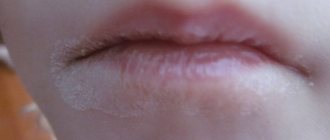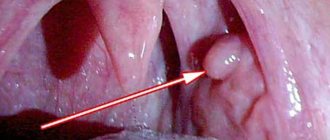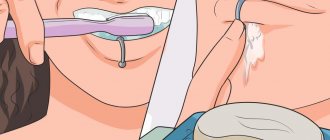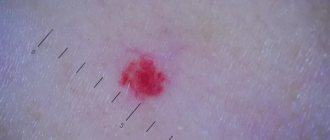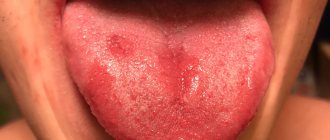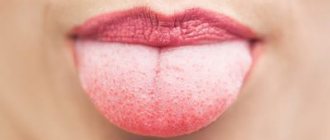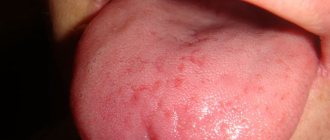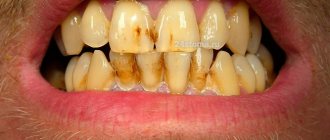Causes of cheilitis
Exposure to adverse weather conditions.
The disease often develops as a result of exposure to unfavorable climatic factors, which include ultraviolet radiation, too low or high air temperature. For this reason, cheilitis often affects people whose work involves regular exposure to fresh air.
Development of an allergic reaction.
One of the reasons for the development of cheilitis is an increase in the sensitivity of the lips to various irritants, mainly of chemical origin.
In this case, the area of the red border of the lips is most often affected and, less often, the mucous membrane. If you do not consult a doctor in a timely manner and do not undergo treatment, the disease can spread to the skin surrounding the lips. Most often, the disease develops due to the use of lipsticks. This is explained by the fact that their composition includes the dye eosin and specific fluorescent substances. The plastic of dentures, aromatic fillers included in toothpastes, etc. can also act as irritants. The disease mainly affects women aged 20-60 years.
Presence of an underlying disease.
Cheilitis on the lips can be a symptom of some disease and manifest itself against the background of neurodermatitis or atopic dermatitis. Eczematous cheilitis is formed with various eczemas, macrocheilitis - with neuritis of the facial nerve in combination with a folded tongue. The most common cause of the disease is dermatoses. The skin of the lips, mucous membrane and red border can also become inflamed with systemic and infectious diseases (psoriasis, tuberculosis, lichen planus, erythematoses, etc.).
Up to contents
Actinic
Reason . Increased sensitivity of the red border of the lips to ultraviolet radiation. The disease appears in the spring-summer season, and by autumn it disappears by itself.
Article on the topic
Lipstick: history of creation and subtleties of use
Symptoms .
The red border of the lower lip swells, becomes bright red, powdered with small white scales. Sometimes small bubbles appear, after opening which crusts form. Patients are concerned about itching, burning, and less often sore lips. Treatment and prevention . You should not only reduce your exposure to sunlight, but also start constantly using sunscreen cosmetics. Ointments with hormones (hydrocortisone, prednisolone, etc.) can be used topically. Inside - vitamins. Rinse your mouth with herbs.
Classification of cheilitis
Primary (independent)
- Glandular
This lip disease is caused by acquired or congenital enlargement of the minor salivary glands and their infection. Most often it affects people over 30 years of age. It is worth noting that the upper lip is affected 2 times less often than the lower lip. At the beginning of the development of the disease, patients are concerned about peeling and slight dryness of the lips. If left untreated, pain may occur due to cracks and erosion.
- Exfoliative
This disease affects only the red border of the lips and is accompanied by peeling.
In most cases, women suffer from this disease. In the dry form, scales form on the lips, a feeling of dryness and burning appears; in the exudative form, swelling and abundant crusts form, making it difficult to eat and speak.
- Contact allergic
This disease is caused by a delayed allergic reaction to various irritants upon contact with the red border of the lips. In most cases, this disease affects women over the age of 20. Signs include redness of the lips, swelling, burning and severe itching. With repeated contact with the irritant, the disease worsens. If treatment for cheilitis is not started in a timely manner, the lip becomes covered with small blisters, after which cracks and erosion appear.
- Meteorological
This disease is caused by increased sensitivity to ultraviolet radiation, wind or cold. In most cases, it affects men aged 20 to 60 years. The exudative form is characterized by itching, burning of the lips, and the appearance of erosion. Small bubbles may appear, after opening which crusts form. In the dry form, erythema of the lips is observed, small white-gray scales appear. If left untreated, abrasions and erosion may develop in the future.
Secondary (symptomatic)
- Atopic
It is believed that this type of disease is one of the manifestations of atopic dermatitis. Patients complain of slight swelling of the red border of the lips, while adjacent areas of the skin are involved in the inflammatory process. Also, manifestations of the disease include damage to the corners of the mouth. When acute inflammation begins to subside, the lip begins to peel off. As a result of dryness in the corners of the mouth, cracks form. In the absence of comprehensive treatment, peeling of the facial skin is possible.
- Eczematous
This disease develops against the background of eczema, which results in inflammation of the surface layers of the skin. In the acute stage, patients complain of redness of the lips, burning and itching. In this case, each lip swells, erythema and pathological changes in the skin are observed. If there is no comprehensive treatment, the disease becomes chronic. In this case, acute inflammatory phenomena (hyperemia, edema) decrease, inflammatory infiltration develops, and nodules and scales may form.
- Hypovitaminosis
This disease in most cases develops against the background of hypo- or avitaminosis of group B. Symptoms of cheilitis include burning and dryness of the tongue, lips and oral mucosa. If the disease is not treated, vertical small cracks appear on the red border of the lips, which often bleed. The tongue may increase in size, and teeth marks are often visible on it.
Up to contents
Meteorological
Reason . Exposure to cold air, strong wind. It occurs more often in men, especially those who suffer from general weather sensitivity or work outdoors.
Symptoms . Peeling, itching and dryness, as well as erosions and crusts on the lips. Cracks in the corners of the mouth.
Treatment and prevention. If possible, minimize exposure to cold and wind. Use protective cosmetics for lips. Take B vitamins internally, as well as PP. Use special wound-healing ointments externally and often rinse your mouth with extracts of chamomile, oak bark, and calendula.
Prevention methods
Careful oral hygiene
To prevent the appearance of cracks, you need to protect the skin and mucous membranes from adverse effects. To do this, you should get rid of the habit of licking your lips and corners of your mouth, using medicinal cosmetics for dry skin and hygienic lipsticks. To prevent infection from getting onto the skin of the lips from the oral cavity, it is necessary to brush your teeth at least twice a day, as well as treat caries and inflammatory gum diseases.
Changing your diet
If pockets begin to appear in the corners of the mouth, it is necessary to limit the consumption of spicy, sour and salty foods that irritate the mucous membranes and skin. You can add non-acidic fruits and vegetables to your daily diet, as well as foods containing iron and riboflavin (beef, liver, dairy products, cabbage, potatoes, peanuts, almonds, etc.).
Up to contents
Allergic
Reason . Increased sensitivity of the red border of the lips to chemicals, for example, dyes contained in toothpaste, lipstick, dentures. Women get sick more often.
Symptoms . It begins with violent swelling and redness of the red border of the lips, which then becomes covered with abundant scales and crusts, and painful cracks form in places.
Treatment and prevention . Drugs that reduce the body's sensitivity to allergens, antihistamines, and vitamins are used. Externally apply lotions from a 2% solution of boric acid, zinc ointment, anti-inflammatory creams containing glucocorticoids, salicylic acid, sulfur. Avoid substances that irritate the oral mucosa and red border of the lips. After eating, rinse your mouth with infusion of chamomile or soda.
Application of METROGYL DENTA®
METROGYL DENTA® is used in the complex treatment of most infectious and inflammatory diseases of the oral cavity, since it has a direct antibacterial effect on pathogenic microorganisms that contribute to the development of inflammation. METROGYL DENTA® does not mask the symptoms of the disease, but helps eliminate the cause of inflammation (pathogenic bacteria). METROGYL DENTA® helps cope with the treatment of cheilitis in adults over 18 years of age.
Up to contents
The information in this article is for reference only and does not replace professional advice from a doctor. To make a diagnosis and prescribe treatment, consult a qualified specialist.
Exfoliative
Reason . Depression, anxiety, vegetoneurosis.
Symptoms . It affects only the middle part of the red border of the lips, while at the edges everything remains normal. Accompanied by either itching and peeling, or the development of swelling and abundant crusts. It occurs mainly in women and young girls, especially those suffering from vegetative neurosis. They often have the habit of licking or biting their lower lip.
Treatment and prevention . Complex therapy uses anti-inflammatory and antibacterial ointments, vitamins, and immunomodulators. An important part of treatment is sedatives or tranquilizers. Sometimes psychotherapy is necessary.
Perioral dermatitis: causes
Experts have not fully identified the causes of perioral dermatitis. However, it is generally accepted that this is a complex, multifactorial disease that has a wave nature (with stages of exacerbation and remission, respectively).
It is usually customary to associate the appearance of a rash around the mouth with hormonal changes that occur:
- when taking various medications, primarily when using ointments based on corticosteroids. Most often, corticosteroids are prescribed as one of the main means for the treatment of acne, rosacea, blackheads, eczema, etc. It is in the case of using corticosteroid ointment that perioral dermatitis can be detected in teenage boys;
- during pregnancy: this type of dermatitis is often diagnosed in women during pregnancy, which makes it possible to assume a hormonal origin of the disease, since pregnancy most often entails serious hormonal changes in the female body. For the same reasons, dermatitis most often worsens before the start of the menstrual cycle. Hormonal changes often occur in newborns, which fully explains the possibility of dermatitis in young children.
Among other things, such dermatitis can occur due to:
- abuse of cosmetics: most often we are talking about both decorative cosmetics (foundation and powder in the first place), and moisturizing creams, scrubs, tonics;
- using fluoride-containing pastes that can irritate the skin around the mouth;
- severe chapping of the skin, especially in the cold, as well as severe insolation (absorption of large amounts of sunlight);
- infections: often during the diagnostic process various infectious agents are discovered (streptococcus, staphylococcus, etc.), but specialists have not yet been able to identify a single agent that can cause the development of this type of dermatitis;
- failure of the immune system, which most often occurs due to a lack of vitamins in the body, especially in adolescents, who during the period of active growth experience a special need for vitamins. In this regard, it is also customary to include an imbalance of intestinal microflora, which occurs due to problems with the digestive organs, as provoking factors for dermatitis.
Perioral dermatitis: consequences
Dermatitis of this type is a very unpleasant dermatological problem, which, in the absence of timely professional intervention, can spread further over the skin of the face. In addition, usually the papules are destroyed, and in their place crusts form, the premature removal of which can cause hyperpigmentation (more intense coloring) of certain areas of the skin.
In case of large skin lesions, especially against the background of weakened immunity, including in children, purulent, weeping ulcers can form in place of papules (pimples), causing patients a lot of discomfort.
In addition, sometimes, in relatively rare cases, oral dermatitis can affect not only the area around the mouth, but also be found on the skin around the eyes, on the lower and upper eyelids. At the same time, dermatitis poses a potential danger to the patient’s vision (primarily if diagnosed in small children), and therefore requires timely consultation with an ophthalmologist
.
Fungal
Reason . Fungal infection Candida albicans. Damage to the red border of the lips is often combined with stomatitis. The disease is promoted by poor oral hygiene, hypovitaminosis B2, long-term use of antibiotics or glucocorticoids, poor nutrition (little protein foods, too many carbohydrates), as well as carbohydrate metabolism disorders.
Symptoms . The lips are swollen, reddened, the edges of the lips are dry and flaky. In the corners of the mouth there are weeping areas with erosions covered with a whitish, easily removable coating.
Treatment and prevention . First, you need to test for a fungal infection. If its presence is confirmed, the doctor will prescribe antifungal drugs, which should be used orally in combination with vitamin B2 and ascorbic acid. Complete sanitation of the oral cavity and careful treatment of problem areas with oil solutions of vitamins are necessary. To prevent relapses, a diet with limited carbohydrates is prescribed.
